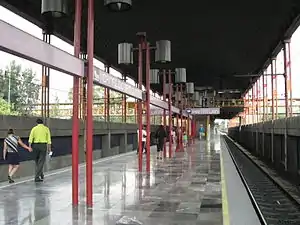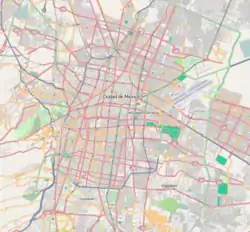Canal de San Juan metro station
Canal de San Juan is a station along Line A of the Mexico City Metro.[2][3] It is located in the Iztacalco municipality. In 2019, the station had an average ridership of 13,188 passengers per day.[4]
| STC rapid transit | |||||||||||||||||||||||||||||||||||||||||||||||||||||||||||||||||||||||||||||||||||||||||||||||||||
 Platform of Canal de San Juan | |||||||||||||||||||||||||||||||||||||||||||||||||||||||||||||||||||||||||||||||||||||||||||||||||||
| General information | |||||||||||||||||||||||||||||||||||||||||||||||||||||||||||||||||||||||||||||||||||||||||||||||||||
| Location | Iztacalco Mexico City Mexico | ||||||||||||||||||||||||||||||||||||||||||||||||||||||||||||||||||||||||||||||||||||||||||||||||||
| Coordinates | 19°23′55″N 99°03′34″W | ||||||||||||||||||||||||||||||||||||||||||||||||||||||||||||||||||||||||||||||||||||||||||||||||||
| Line(s) | |||||||||||||||||||||||||||||||||||||||||||||||||||||||||||||||||||||||||||||||||||||||||||||||||||
| Platforms | 1 island platform | ||||||||||||||||||||||||||||||||||||||||||||||||||||||||||||||||||||||||||||||||||||||||||||||||||
| Tracks | 2 | ||||||||||||||||||||||||||||||||||||||||||||||||||||||||||||||||||||||||||||||||||||||||||||||||||
| Connections | |||||||||||||||||||||||||||||||||||||||||||||||||||||||||||||||||||||||||||||||||||||||||||||||||||
| Construction | |||||||||||||||||||||||||||||||||||||||||||||||||||||||||||||||||||||||||||||||||||||||||||||||||||
| Structure type | At grade | ||||||||||||||||||||||||||||||||||||||||||||||||||||||||||||||||||||||||||||||||||||||||||||||||||
| History | |||||||||||||||||||||||||||||||||||||||||||||||||||||||||||||||||||||||||||||||||||||||||||||||||||
| Opened | 12 August 1991 | ||||||||||||||||||||||||||||||||||||||||||||||||||||||||||||||||||||||||||||||||||||||||||||||||||
| Passengers | |||||||||||||||||||||||||||||||||||||||||||||||||||||||||||||||||||||||||||||||||||||||||||||||||||
| 2022 | 3,282,914[1] | ||||||||||||||||||||||||||||||||||||||||||||||||||||||||||||||||||||||||||||||||||||||||||||||||||
| Rank | 105/195[1] | ||||||||||||||||||||||||||||||||||||||||||||||||||||||||||||||||||||||||||||||||||||||||||||||||||
| Services | |||||||||||||||||||||||||||||||||||||||||||||||||||||||||||||||||||||||||||||||||||||||||||||||||||
| |||||||||||||||||||||||||||||||||||||||||||||||||||||||||||||||||||||||||||||||||||||||||||||||||||
| |||||||||||||||||||||||||||||||||||||||||||||||||||||||||||||||||||||||||||||||||||||||||||||||||||
| Location | |||||||||||||||||||||||||||||||||||||||||||||||||||||||||||||||||||||||||||||||||||||||||||||||||||
 Location within Mexico City | |||||||||||||||||||||||||||||||||||||||||||||||||||||||||||||||||||||||||||||||||||||||||||||||||||
| Area map | |||||||||||||||||||||||||||||||||||||||||||||||||||||||||||||||||||||||||||||||||||||||||||||||||||
Name and pictogram

The station is located on the intersection of Calzada Ignacio Zaragoza and Canal de San Juan. Before it was dried and turned into a thoroughfare, as many other canals and rivers in Mexico City, the Canal de San Juan (San Juan Channel) connected Texcoco and Xochimilco.[2]
Because of this, the pictogram for the station depicts the bow of an Aztec canoe travelling through a canal, commonly associated to the way the Aztecs used to travel along the canals in the Valley of Mexico.[2][3]
General information
The station was opened on 12 August 1991 along the other nine stations of Line A.[5]
As every Line A station, except for Pantitlán, it is an at grade station in the median of Calzada Ignacio Zaragoza with the entrances on both sides of the road connecting to the station through two pedestrian bridges. Due to the design of the station, it has an island platform where passengers can take trains in both eastbound and westbound directions.
It is possible to connect with the bus rapid transit stop of the same name of the Mexico City Metrobús Line 2, which is within walking distance from the metro station.
From 23 April to 25 June 2020, the station was temporarily closed due to the COVID-19 pandemic in Mexico.[6][7]
Ridership
| Annual passenger ridership | |||||
|---|---|---|---|---|---|
| Year | Ridership | Average daily | Rank | % change | Ref. |
| 2022 | 4,134,819 | 11,328 | 105/195 | +25.95% | [1] |
| 2021 | 3,282,914 | 8,994 | 98/195 | +15.25% | [8] |
| 2020 | 2,848,616 | 7,783 | 124/195 | −40.82% | [9] |
| 2019 | 4,813,813 | 13,188 | 134/195 | +8.41% | [4] |
| 2018 | 4,440,479 | 12,165 | 135/195 | −2.36% | [10] |
| 2017 | 4,547,862 | 12,459 | 133/195 | −1.60% | [11] |
| 2016 | 4,621,885 | 12,628 | 130/195 | +4.62% | [12] |
| 2015 | 4,417,962 | 12,104 | 127/195 | −8.51% | [13] |
| 2014 | 4,829,138 | 13,230 | 121/195 | −0.99% | [14] |
| 2013 | 4,877,568 | 13,363 | 122/195 | +1.35% | [15] |
| 2012 | 4,812,479 | 13,148 | 129/195 | −10.69% | [16] |
| 2011 | 5,388,330 | 14,762 | 123/175 | +37.48% | [17] |
| 2010 | 3,919,426 | 10,738 | 123/175 | – | [18] |
References
- "Afluencia de estación por línea 2022" [Station traffic per line 2022] (in Spanish). Sistema Transporte Colectivo Metro. 2023. Archived from the original on 5 March 2023. Retrieved 5 March 2023.
- "Canal de San Juan" (in Spanish). Metro CDMX. Retrieved 30 April 2020.
- Archambault, Richard. "Canal de San Juan » Mexico City Metro System". Retrieved 6 August 2011.
- "Afluencia de estación por línea 2019" [Station traffic per line 2019] (in Spanish). Sistema Transporte Colectivo Metro. 2020. Archived from the original on 8 April 2020. Retrieved 3 May 2020.
- Monroy, Marco. Schwandl, Robert (ed.). "Opening Dates for Mexico City's Subway". Retrieved 5 August 2011.
- "Cierre temporal de estaciones" (PDF) (in Spanish). Metro CDMX. Retrieved 25 April 2020.
- Hernández, Eduardo (13 June 2020). "Coronavirus. Este es el plan para reabrir estaciones del Metro, Metrobús y Tren ligero". El Universal (in Spanish). Retrieved 15 June 2020.
- "Afluencia de estación por línea 2021" [Station traffic per line 2021] (in Spanish). Sistema Transporte Colectivo Metro. 2020. Archived from the original on 7 March 2022. Retrieved 7 March 2022.
- "Afluencia de estación por línea 2020" [Station traffic per line 2020] (in Spanish). Sistema Transporte Colectivo Metro. 2021. Archived from the original on 21 June 2021. Retrieved 21 June 2021.
- "Afluencia de estación por línea 2018" [Station traffic per line 2018] (in Spanish). Sistema Transporte Colectivo Metro. 2019. Archived from the original on 6 June 2019. Retrieved 7 April 2020.
- "Afluencia de estación por línea 2017" [Station traffic per line 2017] (in Spanish). Sistema Transporte Colectivo Metro. 2019. Archived from the original on 3 May 2020. Retrieved 3 May 2020.
- "Afluencia de estación por línea 2016" [Station traffic per line 2016] (in Spanish). Sistema Transporte Colectivo Metro. 2017. Archived from the original on 3 May 2020. Retrieved 3 May 2020.
- "Afluencia de estación por línea 2015" [Station traffic per line 2015] (in Spanish). Sistema Transporte Colectivo Metro. 2016. Archived from the original on 3 May 2020. Retrieved 6 May 2020.
- "Afluencia de estación por línea 2014" [Station traffic per line 2014] (in Spanish). Sistema Transporte Colectivo Metro. 2015. Archived from the original on 3 May 2020. Retrieved 6 May 2020.
- "Afluencia de estación por línea 2013" [Station traffic per line 2013] (in Spanish). Sistema Transporte Colectivo Metro. 2014. Archived from the original on 3 May 2020. Retrieved 6 May 2020.
- "Afluencia de estación por línea 2012" [Station traffic per line 2012] (in Spanish). Sistema Transporte Colectivo Metro. 2013. Archived from the original on 3 May 2020. Retrieved 6 May 2020.
- "Afluencia de estación por línea 2011" [Station traffic per line 2011] (in Spanish). Sistema Transporte Colectivo Metro. 2012. Archived from the original on 7 May 2020. Retrieved 6 May 2020.
- "Afluencia de estación por línea 2010" [Station traffic per line 2010] (in Spanish). Sistema Transporte Colectivo Metro. 2011. Archived from the original on 7 May 2020. Retrieved 6 May 2020.
External links
 Media related to Canal de San Juan (station) at Wikimedia Commons
Media related to Canal de San Juan (station) at Wikimedia Commons